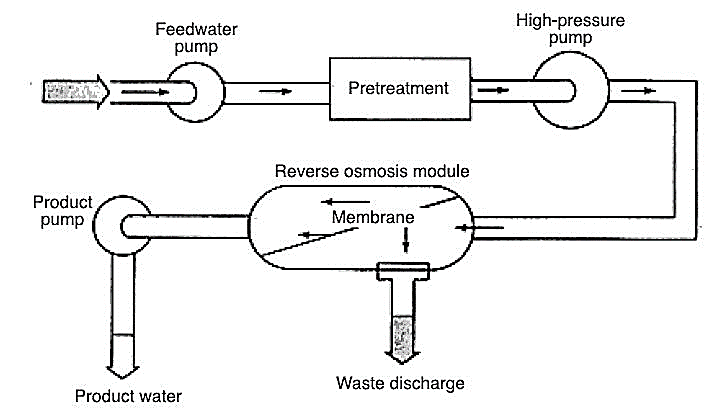
Seawater Desalination with Reverse Osmosis Plant
All Reverse Osmosis crops are generally Desalination Crops but desalination is becoming referred to sea drinking water Ordinarily.As sea water has quite superior TDS demands quite superior pressure to force sea water by way of membranes which are various then brackish drinking water membranes.
Reverse Osmosis Plant Information:
A reverse osmosis plant is usually a producing plant, where h2o is purified and desalinated by forcing h2o via a membrane, typically referred to as a reverse osmosis method. Water produced by plant RO might be used for several functions like desalination, wastewater therapy, and also the reclamation of dissolved minerals.
RO Plant Description
An average ingesting h2o RO plant process calls for six KW hours of energy to desalinate one cubic meter of h2o. Reverse osmosis drinking water plants necessitates several different pre-cure tactics which includes softening, DE chlorination, and anti-scale therapy. Following pre-cure, substantial levels of force deliver h2o by way of a semi-permeable membrane, which retains all contaminants other than water.
RO Plant Style and design
To boost the performance and life of the Reverse Osmosis plant, helpful pretreatment on the feed h2o is needed. Selection of the appropriate pretreatment will maximize effectiveness and membrane life by cutting down:
Fouling
Scaling
Membrane Degradation
RO plant style is consisting of:
Analyzing pretreatment requirement of Reverse Osmosis Plant
If your feed h2o has traces of large metals, it is very recommended to dose some chlorine to change the dissolved significant metals to Actual physical type, the media filter will filter the vast majority of it inside a ro drinking water purifier plant.
Reverse Osmosis Plant Number of membrane
Membrane elements are a crucial Component of RO crops. The proteins (mainly polyamide) that makeup membrane factors range depending on the ending clarity and intake water seawater or brackish water and so on
Waterman engineers Australia RO plant for seawater desalination
Waterman Engineers in Australia has made a Reverse Osmosis (RO) plant for seawater desalination, which presents quite a few advantages more than other desalination strategies. Here are a few crucial advantages of their RO plant:
Vitality Efficiency:
When compared with other desalination tactics like thermal distillation, RO calls for considerably less Strength. Waterman Engineers' RO plant utilizes Superior membrane engineering, enabling it to operate at lessen pressures and cut down Over-all Strength consumption.
Environmental Impact:
RO generates fewer brine discharge when compared to thermal approaches, decreasing the influence on marine ecosystems. This aligns with Australia's concentrate on environmental sustainability and conservation.
Superior Drinking water Purity:
The RO process proficiently removes salts, minerals, and impurities, developing substantial-high quality freshwater that fulfills stringent ingesting drinking water benchmarks. This dependability is very important for delivering safe and clear h2o to communities.
Modular Design and style:
Waterman Engineers' RO plant employs a modular structure, enabling for scalability and adaptability. This is especially advantageous for regions with different water needs, as modules might be included or adjusted accordingly.
Diminished Footprint:
RO crops generally Possess a more compact Actual physical footprint compared to thermal desalination plants, which often demand intensive infrastructure for heating and cooling procedures.
Quick Begin-Up and Shutdown:
RO plants is usually started off and stopped relatively rapidly, enabling for greater responsiveness to transforming drinking water calls for and emergencies.
Decreased Chemical Utilization:
Not like Several other desalination procedures, RO involves less chemical substances for operation and cleansing, reducing chemical-relevant environmental worries.
Consistency in Efficiency:
The RO procedure is much less delicate to feedwater excellent fluctuations than other procedures, making certain a more reliable effectiveness after a while.
Expense-Effectiveness:
When Preliminary expense prices is often considerable, RO crops have a tendency to have decrease operational and maintenance expenditures Over time compared to thermal procedures.
Reverse Osmosis (RO) is really a drinking water purification procedure that works by using a partly permeable membrane to remove ions, undesired molecules, and bigger particles from drinking drinking water. By implementing pressure to overcome osmotic force, it enables the passage of drinking water molecules though rejecting contaminants, thereby generating cleanse h2o on 1 aspect with the membrane and concentrated impurities on the other.
The Functioning theory of the Reverse Osmosis (RO) plant consists of implementing pressure to some saline Answer to pressure h2o molecules via a semi-permeable membrane. This membrane allows only water to pass whilst rejecting salts, contaminants, and impurities, resulting in purified water within the permeate aspect plus a concentrated Option of contaminants to the brine facet.
The benefits of Reverse Osmosis include things like developing superior-high-quality, clean up h2o by taking away contaminants, staying successful and value-successful with time, requiring minimal chemical use, and remaining adaptable to numerous scales of operation from small home units to substantial municipal vegetation.
RO plants have changed Demineralisation (DM) plants because they normally offer a a lot more efficient and value-efficient solution for drinking water purification. RO methods You should not call for the regeneration chemicals that resin-centered DM plants do and will get rid of a broader range of contaminants, which include dissolved solids and microorganisms.
Waterman Engineers Australia most likely takes advantage of Reverse Osmosis (RO) plants for seawater desalination by forcing seawater by way of a semi-permeable membrane to remove salt together Desalination Plant Manufacturer with other impurities. This method generates fresh new, potable water with the ocean, addressing water scarcity and offering a sustainable source for numerous demands.